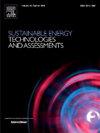Economic and emission reduction Co-benefits of integrating PV systems into EHT battery swap stations in China
IF 7
2区 工程技术
Q1 ENERGY & FUELS
Sustainable Energy Technologies and Assessments
Pub Date : 2025-04-25
DOI:10.1016/j.seta.2025.104336
引用次数: 0
Abstract
Battery swapping is a promising solution to range anxiety for electric heavy-duty trucks, yet its large-scale adoption is hindered by economic viability concerns regarding battery swap stations. While previous studies have highlighted the benefits of optimized configuration, deployment, and charge scheduling, integrating renewable energy—particularly photovoltaic (PV) systems—presents an untapped opportunity for cleaner and more cost-effective battery swap operations. The large batteries of electric trucks offer a unique opportunity for enhanced energy storage and utilization of solar power, contributing to a more sustainable and healthy transportation infrastructure. This study investigates integrating PV systems into electric truck battery swap stations, with a focus on the solar conditions and electricity pricing patterns in China, aiming to advance the development of clean and healthy transportation systems. We employ the Battery Electric Vehicle – Station Configuration & Energy System Optimization (BEV-SCESO) model, utilizing a PSO-GA optimization algorithm to determine the optimal configuration, charge scheduling parameters, and PV system capacities. Economic performance is assessed using a cost-per-kilowatt-hour metric, emphasizing the advantages of PV integration. For a comprehensive analysis, China is divided into six regions based on similar radiation and time-of-use pricing profiles. Results from various demand scenarios reveal significant economic and environmental benefits from photovoltaic integration. Specifically, daytime scenarios show a 14.7% increase in economic performance after PV systems are added, with photovoltaic systems generating 44.8% of station power. The results show that renewable integration in transport infrastructure can reduce environmental impact while improving economic viability for EHTs.
中国将光伏系统集成到EHT电池交换站的经济和减排效益
电池交换是解决电动重型卡车续航里程焦虑的一种很有希望的解决方案,但它的大规模采用受到电池交换站经济可行性问题的阻碍。虽然之前的研究强调了优化配置、部署和充电计划的好处,但整合可再生能源——尤其是光伏(PV)系统——为更清洁、更具成本效益的电池交换操作提供了一个尚未开发的机会。电动卡车的大型电池为增强能源储存和太阳能利用提供了独特的机会,有助于建立更可持续和健康的交通基础设施。本研究探讨了将光伏系统整合到电动卡车电池交换站,重点关注中国的太阳能条件和电价模式,旨在促进清洁和健康交通系统的发展。我们采用纯电动汽车-站配置&;能源系统优化(BEV-SCESO)模型,利用PSO-GA优化算法确定最优配置、充电调度参数和光伏系统容量。使用每千瓦时成本指标评估经济性能,强调光伏集成的优势。为了进行全面分析,根据相似的辐射和使用时间定价概况,将中国分为六个区域。各种需求情景的结果显示,光伏集成具有显著的经济和环境效益。具体而言,白天场景中,增加光伏系统后的经济效益增加了14.7%,光伏系统发电量占电站发电量的44.8%。结果表明,可再生能源在交通基础设施中的整合可以减少环境影响,同时提高EHTs的经济可行性。
本文章由计算机程序翻译,如有差异,请以英文原文为准。
求助全文
约1分钟内获得全文
求助全文
来源期刊

Sustainable Energy Technologies and Assessments
Energy-Renewable Energy, Sustainability and the Environment
CiteScore
12.70
自引率
12.50%
发文量
1091
期刊介绍:
Encouraging a transition to a sustainable energy future is imperative for our world. Technologies that enable this shift in various sectors like transportation, heating, and power systems are of utmost importance. Sustainable Energy Technologies and Assessments welcomes papers focusing on a range of aspects and levels of technological advancements in energy generation and utilization. The aim is to reduce the negative environmental impact associated with energy production and consumption, spanning from laboratory experiments to real-world applications in the commercial sector.
 求助内容:
求助内容: 应助结果提醒方式:
应助结果提醒方式:


